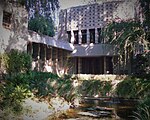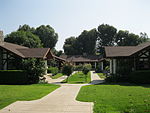Gamble House (Pasadena, California)
American Craftsman architecture in CaliforniaArts and Crafts architecture in CaliforniaBuildings and structures on the National Register of Historic Places in Pasadena, CaliforniaBungalow architecture in CaliforniaCalifornia Historical Landmarks ... and 9 more
Gilded Age mansionsGreene and Greene buildingsHistoric house museums in CaliforniaHouses completed in 1909Houses in Pasadena, CaliforniaHouses on the National Register of Historic Places in CaliforniaMuseums in Pasadena, CaliforniaNational Historic Landmarks in CaliforniaTourist attractions in Pasadena, California

The Gamble House, also known as the David B. Gamble House, is an iconic American Craftsman home in Pasadena, California, designed by the architectural firm Greene and Greene. Constructed in 1908–1909 as a home for David B. Gamble, son of the Procter & Gamble founder James Gamble, it is today a National Historic Landmark, a California Historical Landmark, and open to the public for tours and events.
Excerpt from the Wikipedia article Gamble House (Pasadena, California) (License: CC BY-SA 3.0, Authors, Images).Gamble House (Pasadena, California)
Westmoreland Place, Pasadena
Geographical coordinates (GPS) Address External links Nearby Places Show on map
Geographical coordinates (GPS)
| Latitude | Longitude |
|---|---|
| N 34.151561111111 ° | E -118.1608 ° |
Address
The Gamble House
Westmoreland Place
91102 Pasadena
California, United States
Open on Google Maps







